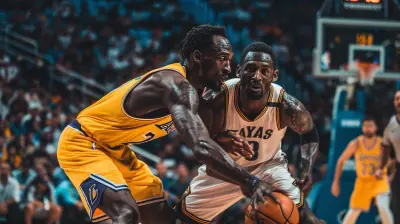The Science of Plyometrics: How Explosive Movements Boost Performance
1 August 2025
Have you ever watched an athlete launch off the ground like a rocket, or explode into a sprint seemingly out of nowhere, and thought—how do they do that? The secret sauce behind those jaw-dropping feats often boils down to one word: plyometrics.
Yeah, it sounds like a mouthful. But trust me, once you understand what plyometrics really does for your body—not just for athletes, but for regular folks too—you’ll want to jump (literally) into it.

What Exactly Is Plyometrics?
Let’s break it down. Plyometrics, often called “jump training,” is a method of exercise where your muscles exert maximum force in short intervals of time, with the goal of increasing power (think speed + strength). You’ll recognize it in moves like box jumps, jump squats, and burpees. Sounds intense? It is. But it's also crazy effective.Think of your muscles like a loaded spring. Plyometrics teaches your body how to load that spring quickly and then explode with power. It's like going from 0 to 60 in a split second—athletically speaking.

A Quick Origin Story
Before plyometrics became the buzzword in training rooms and sports clinics, it had roots in Soviet sports science during the Cold War. Eastern Bloc athletes were crushing international competitions, and a big part of their secret training protocol involved what they called “shock training.” Eventually, American coaches caught on, and by the 1980s, plyometrics started taking over the global sports scene.Fast forward to today—it’s a staple in elite athlete programs, military fitness routines, and even high-intensity group fitness classes.

The Science Behind the Bounce
Alright, let’s geek out (just a little). Plyometric training hinges on something called the Stretch-Shortening Cycle (SSC). It’s a fancy term that describes what happens when you rapidly stretch a muscle (eccentric phase) and then immediately contract it (concentric phase). That quick turnaround is where the magic happens.The Three Phases of Plyometric Movement:
1. Eccentric Phase (Pre-stretch)Basically, the loading phase. Think: squatting down a little before jumping.
2. Amortization Phase
Sounds space-age, right? It’s just the super-quick transition between the downward and upward motion. The shorter this phase, the more force you generate.
3. Concentric Phase (Take-off)
Boom! This is the upward or explosive action. Your muscle switches gears and fires off like a rocket.
When you train this cycle, you teach your nervous system to activate motor units (muscle fibers + nerves) more efficiently. That means quicker movements, more power, and, eventually, better performance in nearly every sport you can imagine.

Why Athletes Swear By It
Ever wonder why sprinters, basketball players, and martial artists look like they’ve got springs in their legs? Plyometrics.Here’s what it really does:
- Increases speed: By training your muscles and nerves to react faster.
- Builds power: You don’t just get stronger—you get explosively strong.
- Improves coordination: When you’re jumping, landing, and sprinting, your body learns to move more efficiently.
- Enhances agility: You’ll be pivoting and changing direction like a pro.
- Boosts endurance: Especially in sports that require short bursts of high effort.
Performance Gains Are Real
In studies, athletes who incorporate plyometrics into their regular training routines often see measurable improvements in their vertical jump, sprint times, and agility drills within just a few weeks. It's not just hype. This stuff works.Not Just for the Pros: Everyday Plyometric Perks
You don’t have to be LeBron or Serena to benefit from this kind of training. Plyometrics is super adaptable.If you’re into:
- Running: Plyometrics can shave time off your sprints and improve stride efficiency.
- Weightlifting: It helps develop explosive lifts like cleans and snatches.
- HIIT workouts: Adds a punch of power and major calorie burn.
- Just staying fit: Even basic jump training can improve balance, joint stability, and bone density.
Got kids? It's excellent for developing coordination and motor skills. Over 50? With proper scaling and supervision, plyos can help maintain muscle power and prevent falls.
Common Plyometric Exercises (And Why They're Awesome)
Wanna try it out? Here are some classics.1. Box Jumps
Great for developing explosive power in your lower body. Start with a low box and work your way up. Land softly like a ninja.2. Jump Squats
Work those quads, glutes, and hamstrings while revving up your heart rate. Keep your core tight and explode upward.3. Burpees
Love them or hate them, burpees are a full-body plyometric blast. They mix push-ups, squats, and jumps for max burn.4. Bounds
These exaggerated running strides help improve sprint power and stride length. Think of leaping like a gazelle.5. Lateral Hops
Side-to-side movement that challenges balance and agility—great for court sports or skiing prep.How Often Should You Train Plyometrics?
Quality over quantity, my friend.Because plyometrics is intense and jarring on the joints, it’s best done 2–3 times per week, with at least one full day of rest between sessions. Think of it as your “specialty” workout. Not your everyday routine.
Tips to Keep It Safe:
- Always warm up first. Dynamic stretches, light jogging, or mobility drills are your best friends here.- Start with lower-impact moves (think jump rope or line hops) before diving into high box jumps.
- Focus on form. Landing softly is key—don’t slam your heels or knees.
- Wear supportive shoes with good grip and cushioning.
- Progress slowly. More height, more reps, or adding weight should come after you’ve built a solid foundation.
The Brain Gains: Neuromuscular Benefits
Let’s not ignore what plyometrics does upstairs.These types of exercises train your body and brain to communicate faster. That neural speed translates into quicker reflexes, better balance, and sharper movement execution. For athletes, faster reaction times can be the difference between scoring or getting scored on.
And for the rest of us? Ever trip over a crack in the sidewalk and catch yourself mid-stumble? That’s your neuromuscular system at work—and plyo training strengthens it.
How Plyometrics Fits into Sports
Every sport has its own need for speed, power, and agility. Here’s how plyometrics supports that:Basketball
Think rebounds, dunks, and quick lateral movements. Plyo helps with vertical leap and fast footwork.Football
Need that explosive first step off the line or the ability to absorb and redirect forces? That’s plyo training in action.Soccer
Cutting on a dime, controlling your body mid-air, or unleashing a powerful kick? Yep—plyometrics.Track & Field
Sprinters live for plyo drills because they build fast-twitch muscle power and stride length.Martial Arts
Throwing punches, dodging kicks, and executing takedowns all rely on the elastic recoil that plyometrics sharpens.What About Weight Loss?
Oh yes, let’s not overlook this.Plyometric movements are metabolically demanding. That means they torch calories—fast. Add them to your workouts, and you’ll:
- Burn fat
- Build lean muscle
- Boost metabolism (even after your workout ends)
- Improve cardiovascular fitness
Talk about a full-body win.
The Mental Edge
There’s something about conquering a high box jump or nailing a set of burpees that builds mental grit. You’ll push through limits, face mini fears (yes, that box can be intimidating), and walk out of each session feeling like a boss.It’s not just physical power—it’s confidence in motion.
Final Thoughts: Jump into It
Here’s the deal: plyometrics isn’t some fringe workout for elite athletes only. It’s one of the most functional, efficient, and exciting ways to level up your performance, regardless of whether you’re chasing a gold medal or just want to feel a little more spring in your step.It’s about upgrading your body’s ability to move quickly, powerfully, and smartly.
So next time you’re at the gym—or even in your living room—try adding a little bounce to your routine. Because once you start jumping, you won’t want to stop.
all images in this post were generated using AI tools
Category:
Sports ScienceAuthor:

Nelson Bryant
Discussion
rate this article
1 comments
Amalia Coleman
Plyometrics: where physics meets sports. A leap in training that transforms mere athletes into explosive powerhouses—science never looked so athletic!
August 19, 2025 at 10:52 AM

Nelson Bryant
Absolutely! Plyometrics truly harnesses the principles of physics to elevate athletic performance, transforming strength into explosive power. It's amazing how science and sport can combine to create such impactful training!


